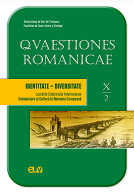La rappresentazioni dei protagonisti nei romanzi storici Ettore Fieramosca e Niccolò de’ Lapi di Massimo d’Azeglio dalla prospettiva della formazione dell’identità nazionale
The representations of the protagonists in the historical novels Ettore Fieramosca and Niccolò de' Lapi by Massimo d'Azeglio from the perspective of the formation of national identity
Author(s): Mónika Kitti FarkasSubject(s): Theory of Literature, Identity of Collectives, Italian literature, Sociology of Literature
Published by: Universitatea de Vest din Timişoara
Keywords: Massimo d'Azeglio; Ettore Fieramosca; Niccolò de' Lapi; national identity; character representation;
Summary/Abstract: Ettore Fieramosca (1833) and Niccolò de' Lapi (1841) are d'Azeglio's first historical fictions with which he wanted to boost Risorgimento aspirations. The present work aims to examine the common features and the differences of the protagonists of the two novels to identify the personal characters that d'Azeglio considered essential for the formation of the national identity of the Italians. Ettore Fieramosca becomes one of the duelling knights of the duel of Barletta. He is a young soldier who embodies the virtues of chivalry: the story takes place during the Franco-Spanish war in 1503, after the French soldier La Motta insulted the honour of the Italians. In contrast, Niccolò de' Lapi is an old man of almost 90 who is no longer able to fight actively against the foreign invasion, but who keeps alive the memory of the freedom of the Florentine Republic. My hypothesis is that, despite the differences in age, profession and mentality of the two characters, and the differences in historical and political context, d'Azeglio wanted to offer through the protagonists the same model for the Italian Risorgimento society to follow and to draw attention to the importance of the role that national identity had to take in the new society. Despite the fact that d'Azeglio's historical novels propose different themes (1503 Southern Italy, 1529 Florence, etc.), they have a common thread of orientation that links them directly and organically with the author's artistic and ideological credo, thereby contributing to the development of the historical fiction.
Journal: Quaestiones Romanicae
- Issue Year: X/2023
- Issue No: 2
- Page Range: 178-192
- Page Count: 15
- Language: Italian

